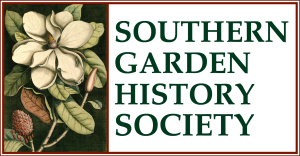
Credit: Library of Congress Prints and Photographs Division Washington, D.C. 20540 USA
Society members have visited Andrew and Rachel Jackson’s home and gardens twice, the first time in 1988 during a Nashville annual meeting Sunday tour and the next in May 2015 as part of regularly scheduled activities organized for Nashville meeting number two. Those familiar with the site recall that between these gatherings The Hermitage endured a monumental blow from an April 1998 tornado, an event referenced in several issues of Magnolia. The storm, which destroyed well over a thousand trees, including cherished Jackson-era specimens, became an event that is now central to The Hermitage’s landscape story.* (Despite such damage, the Jackson homesite still includes an impressive Level III arboretum and offers a good look at trees native to the area.)
In 1988, members experienced the third landscape in a row intimately associated with a U.S. president, having been to Jefferson’s Monticello and the Madisons’ Montpelier in 1987. Thus, in 1987 they visited sites with roots in Virginia’s colonial past, while at The Hermitage they found gardens and grounds set firmly in a new state and a new nation. Aside from being presidential sites, of course, all were large-scale plantations, and a central part of the message they convey relates to their enslaved communities. At the Hermitage a “Landscape of Inequality” interpretive sign helps present the picture, in conjunction with early buildings such as “Alfred’s Cabin” and “The First Hermitage,”** archaeological sites, and discussions of cotton growing activities on the Jackson lands.
Amidst this “Landscape of Inequality,” the Jacksons’ large home, as rebuilt and remodeled several times achieved full domain over its setting through the addition of commanding two-story columns and porches on both the principal facade and, most unusually, also on the rear of the dwelling. Especially well-known is the guitar-form and cedar-lined entry drive, a feature struck hard by the 1998 storm and since replanted. The house site also stands out for its extensive, character-defining, white post-and-board fences, their current positions confirmed via archaeological testing.
Perhaps best recalled by 1988 SGHS visitors, however, was the formal garden east of the mansion, a space closely linked to Rachel Jackson’s memory and keyed to her enjoyment of flowers. The present garden’s formal layout, however, post-dates Rachel by several decades, taking shape while owned by Andrew Jackson, Jr., this also being a time near the end of the Jackson family’s ownership of The Hermitage. Although the State of Tennessee was to acquire the property, limited maintenance meant the mansion and garden’s status echoed the Civil War-era decline of Mount Vernon. Fortunately, the women of Tennessee followed the model of those at the Washingtons’ home and founded the Ladies’ Hermitage Association. Formed in 1889, the group (known since 2014 as the Andrew Jackson Foundation) acquired the home and twenty-five acres and began the efforts that led ultimately to the National Historic Landmark site seen today.
The most significant corner of The Hermitage’s formal garden is that given over to the graves of Rachel and Andrew Jackson and their David Morrison-designed tomb, a structure which echoes his Greek Revival classicism work on the mansion. The garden itself is set out in quincunx fashion (five-part), with the brick-edged spaces offering ample areas for a wide range of plants, including those known to have been favored by the Jacksons, along with heirlooms dating from the early-twentieth century or before.*** In recalling the second SGHS visit, meeting reviewer and a past-president, Perry Mathewes, spoke in the Spring 2015 Magnolia of “chestnut roses in bloom along with sweeps of foxglove, sweet William, and rose campion.” A poignant 1988 memory is indeed of the chestnut rose, and in particular there is a sharp recollection of rosarian and author Bill Welch’s walk-about discussion of that and other Rosaceae specimens we found. Then and there Dr. Welch, later a Society president and a winner of both the Bynum Medal and the Hunt Award, instilled in this writer a fascination for antique roses that has survived ever since.
At another level, however, credit for this is due to the guiding presence of the 1988 meeting organizers Ben (later also to be a SGHS president) and Libby Page, both being charter members of the Southern Garden History Society. Twenty-seven years hence they would join forces with Carnton Plantation’s gardens and grounds director and former SGHS board member, Justin Stelter, to pilot the 2015 Nashville-based meeting, focusing on the wider landscape sweep of middle Tennessee. Together, for over four decades the Pages have personified the essence of the Southern Garden History Society.
****************************************************************
*For a succinct discussion of the fall 1998 storm and of shifting landscape policies at The Hermitage, see Davyd Foard Hood’s review of The Hermitage Landscape: Before and after the 1998 Tornado, written by Fletch Coke: https://southerngardenhistory.org/wp-content/uploads/2015/12/Magnolia_Fall_1999.pdf#page=13. Long-time members might recall that Hermitage historian Fletch Coke and a one-time SGHS board member spoke and led a tour during the 1988 visit to The Hermitage.
**This was the initial, log-constructed, home of the Jacksons prior to building of the first iteration of their mansion house.
***For further details on The Hermitage landscape, see: https://thehermitage.com/garden–mansion-features

Leave a Reply